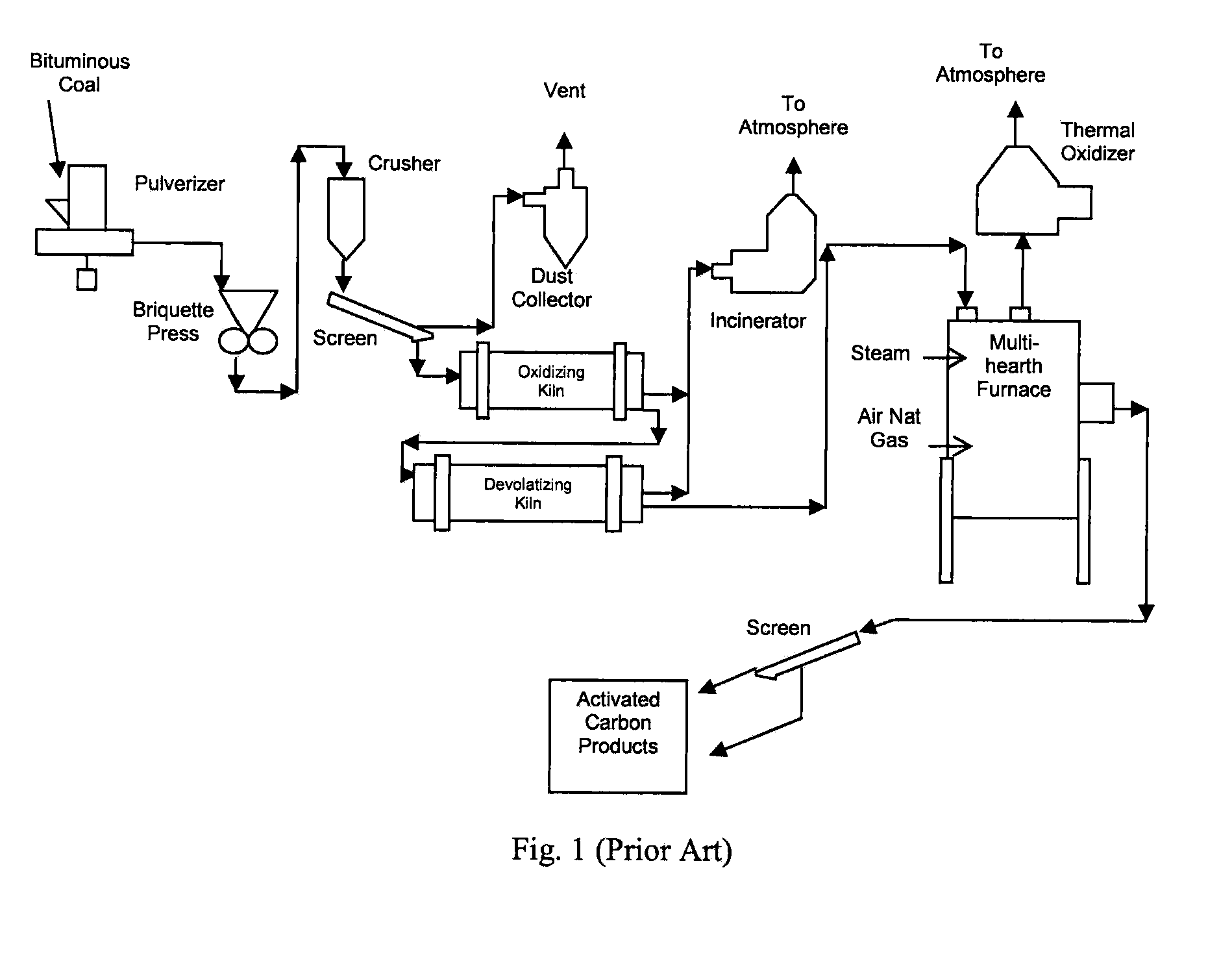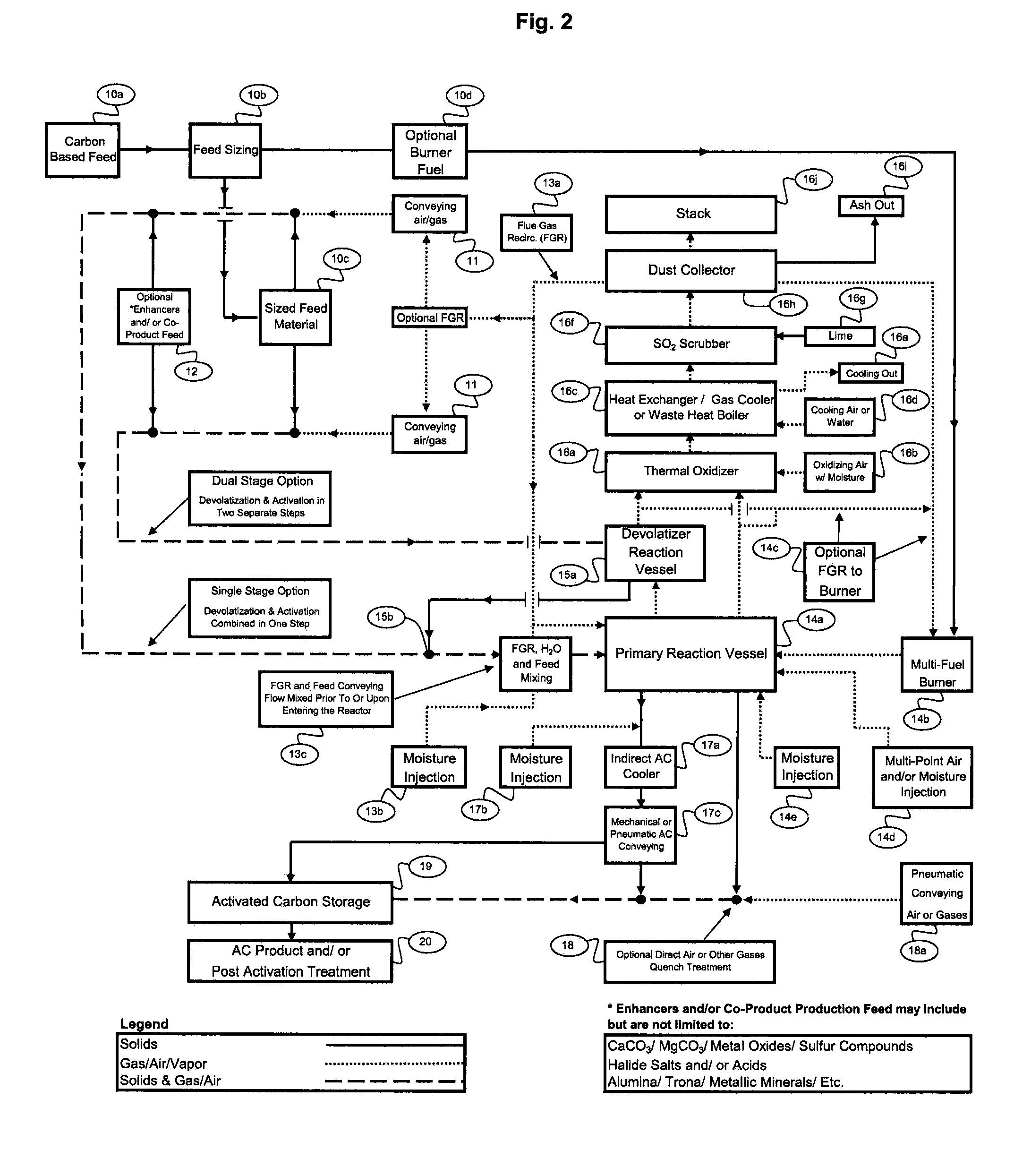[0025]5. Another key factor is the need to prevent carbonaceous feed
particulates from undergoing adverse
reaction conditions such as overheating and / or favoring partial
combustion reactions thereby affecting the yield and pore structure. The process must also be able to retain the coarser feed material longer than the finer material. This can all be accomplished by the cyclonic flow pattern within the Reactor created by the injection of carbonaceous feed either mechanically or pneumatically and using a conveying gas and / or the injection of second gas such as re-circulated
flue gases or steam to create a cyclonic
material flow pattern. Cyclonic gas flow rotational velocities within the Reactor should be a minimum of 90 RPM average velocity and more ideally in the 120 to 240 RPM range. Cyclonic flow in the Reactor in conjunction with the feed conveying gas and or secondary
gas composition creates a more uniform AC product by buffering the carbonaceous feed from excessive Reaction Vessel temperatures caused by the burner
flame and / or from excessive partial combustion of the feed. By utilizing this method, adverse
carbon particle surface reactions, ash fusion, excessive gasification and product loss is avoided. In addition cyclonic flow in the Reactor increases particulate
retention time by creating a
helical material flow pattern thereby increasing the particle
path length.
[0030]10. The design of the Reaction Vessel, which again is defined as the vessel(s) from carbonaceous feed injection through to the product disengagement and separation from reaction gases, must create an oxidizing environment transitioning to a reducing environment. For many precursor materials the initial oxidizing environment prior to transitioning to a reducing environment can be beneficial as a pretreatment of the feed material surface area immediately prior to activation as an additional means to control adverse reactions. When utilizing
Single Stage Activated Carbon Production in a single Reaction Vessel, devolatilization occurs in an oxidizing transitioning to a reducing environment and the activation occurs in primarily a reducing gas environment. To assist in creating distinct regions additional gases such as air, re-circulated
flue gas, and / or
moisture can be added at various points along the gaseous flow path of the Reaction Vessel thereby creating distinct reaction zones within the Reaction Vessel. When utilizing
Dual Stage Activated Carbon Production in multiple Reaction Vessels, activation occurs in an oxidizing transitioning to a reducing environment in a single Reaction Vessel. The devolatilization occurs in primarily a reducing gas environment in a separate Reaction Vessel which utilizes the separated flue gases from the first Reaction Vessel as the heat source. To assist in creating distinct regions when utilizing
Dual Stage Activated Carbon Production additional gases such as air, re-circulated
flue gas, and / or
moisture can be added at various points along the gaseous flow path of either or both of the Reaction Vessels.
[0032]12. Moreover, by including a co-product
industrial mineral to be calcined, such as
magnesium,
trona, or
calcium carbonate, a
calcination product (e.g.,
lime) can be produced simultaneously with the activated carbon and can further be a source of
temperature control due to the endothermic nature of
calcination. The co-produced or co-product industrial minerals are defined as minerals that are capable of undergoing
calcination under the same operating conditions as the carbon being
heat treated and that represents at least 50% of the heat-
treatment system output in terms of quantity. So, for example, limestone is introduced with the carbon being
heat treated in sufficient quantity that it results in at least 50% of the output (in the form of
lime) in addition to activated
char. Thus, co-product industrial minerals are to be distinguished from mere “enhancers,” which are added to the
system but do not result in a separate “co-product” in any appreciable amounts (and certainly not over 50% of the
system output of products). For example, adding a
bromide dopant to the carbon would be considered a an
enhancer and not a co-product
industrial mineral because mainly brominated carbon results, with no other “co-product” making up at least 50% of the
system output of products. Of course, the co-product industrial minerals can add to the effectiveness of the AC. For example the removal of
sulfur in
coal power plant flue gases with lime can benefit the ability of AC to adsorb mercury. Another example is the
industrial mineral commonly referred to as
trona where when co-calcined with AC can benefit the
mercury adsorption by not only removing
sulfur compounds but by also adsorbing mercury in the
trona pore structure created during calcination.
[0034]14. Furthermore, this method of AC production lends itself to pre-activation
halide compound treatments, such as bromination. This treatment can occur in several ways such as the premixing of
halide salts such as
sodium bromide,
calcium bromine or iron
bromide or a combination of halides with the carbon precursor material resulting in the concurrent activation and
halide treatment of the AC. Due to the
thermal treatment conditions, the concurrent activation and
halogenation of the carbon precursor can have a positive
impact on the effectiveness of the
halogenation of the activated carbon.
[0036]Overall there is a need for a process that can significantly reduce the
capital cost requirements for AC production and
processing and that is inherently stable, easily adjustable, and precisely repeatable.
 Login to View More
Login to View More  Login to View More
Login to View More 









